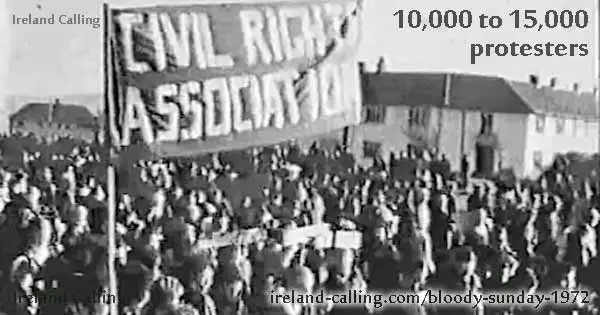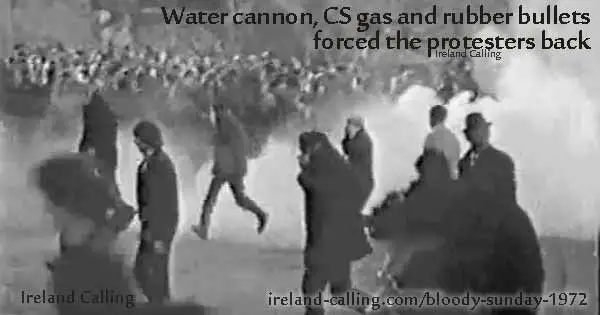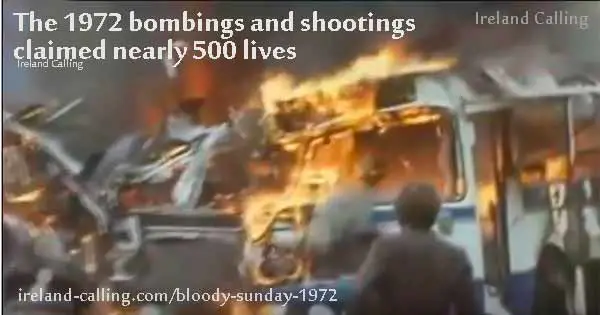Bloody Sunday was one of the most tragic and controversial days in the whole history of the Troubles. It had widespread repercussions and changed Northern Ireland forever.
On 30 January 1972, British troops shot dead 13 civilians taking part in a civil rights march in Derry. A further 13 people were seriously wounded and one of them died later in hospital. The dead were all men aged between 17 and 41. The seriously wounded included a woman and a 15-year-old boy.
Television cameras broadcast news across the world. The image of Catholic priest Fr Edward Daly waving a white handkerchief as he tried to help a wounded victim became one of the most memorable images from the Troubles.
Marchers were protesting against internment without trial
The people taking part in the march that day were protesting against internment, which allowed security forces to round up suspects and keep them in prison without trial. Within a few months, hundreds of Catholics had been interned, most of whom were later released and had nothing to do with the IRA or any other paramilitary organisation. During this period, no Protestants had been interned.


Catholics saw this as blatantly biased and the Northern Ireland Civil Rights Association organised a protest march. Political demonstrations had been banned by the government the previous August but an estimated 10,000 to 15,000 protesters went ahead anyway.
They had intended to march to the Guildhall Square in the centre of the city but the army had erected barricades to stop them. The organisers then redirected the march towards the Free Derry Corner, but some protesters continued on the intended route towards the Guildhall.
When they arrived at the army barricades, some protesters started throwing stones at the troops, who responded with water cannon, CS gas and rubber bullets. This forced the protesters back and as they began to disperse, soldiers were ordered to arrest as many of them as they could.
Then suddenly, soldiers from the Parachute Regiment started firing live ammunition. Other units joined in.
The troops later claimed they only fired because they were being attacked themselves by snipers and nailbombers. This was disputed by witnesses on the day who said there were no attacks and no justification for opening fire. The IRA denied that they had any active units involved.
The attack caused outrage among the Nationalist community. Protests went on for days and in Dublin, the British Embassy was set alight. The British ambassador Sir John Peck later wrote in his memoires: “Bloody Sunday had unleashed a wave of fury and exasperation the like of which I had never encountered in my life, in Egypt or Cyprus or anywhere else. Hatred of the British was intense. Someone had summed it up: We are all IRA now.”
IRA bombed HQ of Parachute Regiment killing 7 civilians

The IRA sought revenge for Bloody Sunday by attacking the Parachute Regiment’s HQ in Aldershot in England. The bombing failed to kill paratroopers as intended but instead killed a Catholic chaplain, and six civilian members of staff. There were further IRA bombings in Belfast city centre, killing nine people and injuring many more.
The attacks were part of a series of bombing and shootings that were to make 1972 the most violent year throughout the Troubles, claiming the lives of nearly 500 people.
The repercussions from Bloody Sunday were enormous. It radicalised thousands of young Catholics and many of them flocked to the join the IRA as a way of protecting their community and protesting against what they saw as state terrorism. Sinn Féin president Gerry Adams said: “Money, guns and recruits flooded into the IRA.”
Bloody Sunday hastened the end of Northern Ireland’s parliament at Stormont. Within a few months, Britain’s Prime Minister Ted Heath decided that the Stormont government was no longer in control and so he introduced direct rule from London. Never again would the Unionists enjoy unbridled power.
The way troops opened fire also created serious doubts about their role in Northern Ireland. Nationalists had long since regarded them as an oppressive force, there to prop up the Unionist establishment rather than serve both communities equally. Now the rest of the world began to wonder about the neutrality of the security forces.
The reason for the troops opening fire became an ongoing source of controversy with claim and counterclaim and two major inquiries spread out over 30 years.
Derry coroner describes Bloody Sunday as ‘murder’
The Derry coroner, Major Hubert O’Neill who was a former British Army Officer, held inquests into the deaths of the 13 victims. When the inquests were completed, he made a state on 21 August, 1973 describing the shootings as “unadulterated murder”.
He said: “It strikes me that the Army ran amok that day and shot without thinking what they were doing. They were shooting innocent people. These people may have been taking part in a march that was banned but that does not justify the troops coming in and firing live rounds indiscriminately. I would say without hesitation that it was sheer, unadulterated murder. It was murder.”
An inquiry immediately after Bloody Sunday by England’s Lord Chief Justice, Lord Widgery concluded that the first shots on the day had been fired by the demonstrators but none of the dead appeared to have been armed. His report exonerated the army but said that the actions of the paratroopers in opening fire had “bordered on the reckless”.
Widgery also raised suspicions about some of the victims and suggested they had been handling bombs and guns.
The allegations against the victims infuriated Nationalists who dismissed the report as a whitewash. They spent more than 20 years campaigning for a new and full inquiry. In 1998, British Prime Minister Tony Blair appointed Lord Saville to carry out a fresh investigation.
Saville report said the killings were unjustified

Saville’s report said that the first shot had been fired by the army. He added that there had been some firing by Republican paramilitaries but it did not justify the shooting of the unarmed demonstrators.
Saville also said that none of the soldiers responsible for the killings had fired in response to attacks by protesters throwing stones or other objects, and none of those who were shot had posed a threat to soldiers.
Lord Saville concluded: “What happened on Bloody Sunday strengthened the Provisional IRA, increased nationalist resentment and hostility towards the Army and exacerbated the violent conflict of the years that followed. Bloody Sunday was a tragedy for the bereaved and the wounded, and a catastrophe for the people of Northern Ireland.”
Following the Saville report, British Prime Minister David Cameron made a speech in Parliament in 2010 to apologise for the shootings, which he described as “unjustified and unjustifiable”.
Mr Cameron said: “I am deeply patriotic. I never want to believe anything bad about our country. I never want to call into question the behaviour of our soldiers and our army, who I believe to be the finest in the world. And I have seen for myself the very difficult and dangerous circumstances in which we ask our soldiers to serve. But the conclusions of this report are absolutely clear. There is no doubt, there is nothing equivocal; there are no ambiguities. What happened on Bloody Sunday was both unjustified and unjustifiable. It was wrong.”
In 2011, Britain agreed to pay compensation to the injured and the relatives of those who were killed.
Read Mr Cameron’s statement in full.
troubles.html